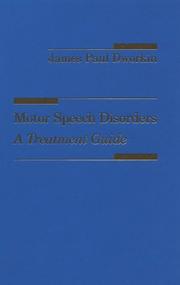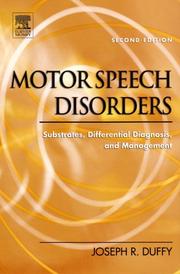| Listing 1 - 10 of 32 | << page >> |
Sort by
|
Book
Year: 2017 Publisher: Amsterdam Pearson
Abstract | Keywords | Export | Availability | Bookmark
 Loading...
Loading...Choose an application
- Reference Manager
- EndNote
- RefWorks (Direct export to RefWorks)
Book
ISBN: 1557661375 Year: 1994 Publisher: Baltimore, MD : Paul H. Brookes Publishing Co.,
Abstract | Keywords | Export | Availability | Bookmark
 Loading...
Loading...Choose an application
- Reference Manager
- EndNote
- RefWorks (Direct export to RefWorks)
DYSARTHRIA --- DYSARTHRIA --- VOICE DISORDERS --- VOICE DISORDERS --- DIAGNOSIS --- THERAPY --- DIAGNOSIS --- THERAPY --- DYSARTHRIA --- DYSARTHRIA --- VOICE DISORDERS --- VOICE DISORDERS --- DIAGNOSIS --- THERAPY --- DIAGNOSIS --- THERAPY
Book
ISBN: 9789026517679 Year: 2005 Publisher: Amsterdam Harcourt Book Publishers
Abstract | Keywords | Export | Availability | Bookmark
 Loading...
Loading...Choose an application
- Reference Manager
- EndNote
- RefWorks (Direct export to RefWorks)
26517679
Dysarthria --- Dysarthosis --- Dysarthria, Flaccid --- Dysarthria, Guttural --- Dysarthria, Mixed --- Dysarthria, Scanning --- Dysarthria, Spastic --- Dysarthoses --- Dysarthrias --- Dysarthrias, Flaccid --- Dysarthrias, Guttural --- Dysarthrias, Mixed --- Dysarthrias, Scanning --- Dysarthrias, Spastic --- Flaccid Dysarthria --- Flaccid Dysarthrias --- Guttural Dysarthria --- Guttural Dysarthrias --- Mixed Dysarthria --- Mixed Dysarthrias --- Scanning Dysarthria --- Scanning Dysarthrias --- Spastic Dysarthria --- Spastic Dysarthrias --- Dysartrie --- Apraxie --- Logopedie
Book
ISBN: 9781111138271 1111138273 Year: 2012 Publisher: Australia: Delmar/Cengage Learning,
Abstract | Keywords | Export | Availability | Bookmark
 Loading...
Loading...Choose an application
- Reference Manager
- EndNote
- RefWorks (Direct export to RefWorks)
MOTOR SPEECH DISORDERS: DIAGNOSIS AND TREATMENT, 2E offers a detailed yet streamlined introduction to motor speech disorders. The text opens with a brief historical review of motor speech disorders, providing useful context for understanding the technology and methodology modern speech-language pathologists employ for evaluation and treatment today. Without overwhelming students with complex detail, the text also provides a practical introduction to the human motor system, including the anatomy and physiology involved in motor speech disorders. A series of chapters offers an in-depth look at the six pure dysarthrias, as well as mixed dysarthria and apraxia of speech, including detailed information on etiology, characteristics, and treatment. MOTOR SPEECH DISORDERS: DIAGNOSIS AND TREATMENT, 2E has been updated with high quality illustrations, as well as information on cutting-edge treatment procedures and current best practices. An accompanying DVD features clinical videos to deepen students' understanding of the disorders by exposing them to real-life case examples
Dysarthria --- Dysarthria --- Dysarthrie --- Speech Disorders --- Speech Disorders --- Troubles de la parole --- Articulation disorders --- Articulation disorders

ISBN: 1556642237 Year: 1991 Publisher: Saint Louis Mosby-Year Book
Abstract | Keywords | Export | Availability | Bookmark
 Loading...
Loading...Choose an application
- Reference Manager
- EndNote
- RefWorks (Direct export to RefWorks)
Speech therapy --- Apraxias --- Dysarthria --- Speech Therapy --- therapy --- therapy
Book
ISBN: 9782353270217 2353270212 Year: 2007 Publisher: Louvain-la-Neuve : De Boeck Solal,
Abstract | Keywords | Export | Availability | Bookmark
 Loading...
Loading...Choose an application
- Reference Manager
- EndNote
- RefWorks (Direct export to RefWorks)
Dissertation
Year: 2021 Publisher: Liège Université de Liège (ULiège)
Abstract | Keywords | Export | Availability | Bookmark
 Loading...
Loading...Choose an application
- Reference Manager
- EndNote
- RefWorks (Direct export to RefWorks)
La communication verbale est permise grâce au langage articulé : la parole. Certaines lésions neurologiques sont susceptibles d’occasionner des troubles moteurs au niveau de cet aspect, prenant la forme de deux pathologies distinctes : l’anarthrie et la dysarthrie (Kent, 2000). Ces syndromes proviennent de l’altération de mécanismes différents : l’anarthrie apparaît consécutivement à un déficit des processus de planification et de programmation du geste moteur ; tandis que les difficultés rencontrées par le patient dysarthrique proviennent de l’altération des processus d’exécution de la parole (Code, 1998). Bien que leur origine soit différente, il n’est pas toujours aisé de parvenir à distinguer ces troubles d’une part car certains de leurs symptômes sont similaires (Duffy, 2012) et d’autre part car la réalité clinique manque cruellement d’outils diagnostics standardisés destinés à les évaluer et les différencier. Disposer de moyens d’évaluation fiables, permettant d’identifier correctement ces troubles est pourtant essentiel pour proposer une prise en charge spécifique au profil du patient et à ses difficultés ; il s’agirait même d’un gage de qualité et d’efficacité du traitement mis en place (Abbs & De Paul, 1989 cités par Roy et al., 2001). Face à une telle problématique, un outil d’évaluation devait être élaboré. Ce dernier devait prendre en considération les données scientifiques disponibles quant aux épreuves capables de mettre en évidence la présence de l’un ou l’autre de ces troubles sur base des résultats obtenus. L’outil finalement développé comporte 8 tâches ayant démontré leur intérêt dans le diagnostic différentiel de ces deux pathologies : langage spontané, langage descriptif, lecture, répétition de mots, répétition de non-mots, langage automatique, répétition de triplets et praxies bucco-linguo-faciales. Afin de tester ces épreuves, nous les avons administrées à un groupe de 20 sujets contrôles puis à 3 patients présentant une anarthrie ou une dysarthrie. Les résultats obtenus par ces administrations sont prometteurs : l’outil s’est révélé relativement efficace pour orienter correctement le diagnostic. Si la majorité des données récoltées sont en accord avec nos hypothèses, certains éléments soulèvent cependant quelques limites présentées par l’outil actuel. Certaines améliorations mériteraient ainsi d’être envisagées par les travaux futurs dans l’objectif de proposer, à terme, un outil d’évaluation spécifique et sensible pour le diagnostic différentiel de ces troubles.
Dissertation
ISBN: 9051660464 Year: 1988 Publisher: Delft Eburon
Abstract | Keywords | Export | Availability | Bookmark
 Loading...
Loading...Choose an application
- Reference Manager
- EndNote
- RefWorks (Direct export to RefWorks)
Child. --- Dysarthria. --- Speech Disorders. --- Aphasia. --- #KVHB:Afasie --- #KVHB:Dysartrie --- Alogia --- Anepia --- Aphasia, Ageusic --- Aphasia, Auditory Discriminatory --- Aphasia, Commisural --- Aphasia, Functional --- Aphasia, Global --- Aphasia, Graphomotor --- Aphasia, Intellectual --- Aphasia, Mixed --- Aphasia, Post-Ictal --- Aphasia, Post-Traumatic --- Aphasia, Progressive --- Aphasia, Semantic --- Aphasia, Syntactical --- Dejerine-Lichtheim Phenomenon --- Dysphasia, Global --- Lichtheim's Sign --- Logagnosia --- Logamnesia --- Logasthenia --- Aphasia, Acquired --- Dysphasia --- Acquired Aphasia --- Ageusic Aphasia --- Ageusic Aphasias --- Alogias --- Anepias --- Aphasia, Post Ictal --- Aphasia, Post Traumatic --- Aphasias, Ageusic --- Aphasias, Auditory Discriminatory --- Aphasias, Commisural --- Aphasias, Functional --- Aphasias, Global --- Aphasias, Graphomotor --- Aphasias, Intellectual --- Aphasias, Mixed --- Aphasias, Post-Ictal --- Aphasias, Post-Traumatic --- Aphasias, Progressive --- Aphasias, Semantic --- Aphasias, Syntactical --- Auditory Discriminatory Aphasia --- Auditory Discriminatory Aphasias --- Commisural Aphasia --- Commisural Aphasias --- Dejerine Lichtheim Phenomenon --- Discriminatory Aphasia, Auditory --- Discriminatory Aphasias, Auditory --- Dysphasias, Global --- Functional Aphasia --- Functional Aphasias --- Global Aphasia --- Global Aphasias --- Global Dysphasia --- Global Dysphasias --- Graphomotor Aphasia --- Graphomotor Aphasias --- Intellectual Aphasia --- Intellectual Aphasias --- Lichtheim Sign --- Lichtheims Sign --- Logagnosias --- Logamnesias --- Logasthenias --- Mixed Aphasia --- Mixed Aphasias --- Phenomenon, Dejerine-Lichtheim --- Post-Ictal Aphasia --- Post-Ictal Aphasias --- Post-Traumatic Aphasia --- Post-Traumatic Aphasias --- Progressive Aphasia --- Progressive Aphasias --- Semantic Aphasia --- Semantic Aphasias --- Sign, Lichtheim's --- Syntactical Aphasia --- Syntactical Aphasias --- Dominance, Cerebral --- Landau-Kleffner Syndrome --- Aprosodic Speech --- Cluttering --- Dysglossia --- Dyslalia --- Rhinolalia --- Verbal Fluency Disorders --- Aprosodia --- Aprosodias --- Clutterings --- Dysglossias --- Dyslalias --- Rhinolalias --- Speech, Aprosodic --- Verbal Fluency Disorder --- Language Disorders --- Velopharyngeal Insufficiency --- Verbal Behavior --- Dysarthosis --- Dysarthria, Flaccid --- Dysarthria, Guttural --- Dysarthria, Mixed --- Dysarthria, Scanning --- Dysarthria, Spastic --- Dysarthoses --- Dysarthrias --- Dysarthrias, Flaccid --- Dysarthrias, Guttural --- Dysarthrias, Mixed --- Dysarthrias, Scanning --- Dysarthrias, Spastic --- Flaccid Dysarthria --- Flaccid Dysarthrias --- Guttural Dysarthria --- Guttural Dysarthrias --- Mixed Dysarthria --- Mixed Dysarthrias --- Scanning Dysarthria --- Scanning Dysarthrias --- Spastic Dysarthria --- Spastic Dysarthrias --- Children --- Minors --- Theses --- Aphasia --- DYSARTHRIA --- SPEECH DISORDERS, in infancy and childhood --- APHASIA --- childhood --- in infancy and childhood --- ACQUIRED, in infancy & childhood --- SPEECH DISORDERS, in infancy and childhood. --- childhood. --- in infancy and childhood. --- ACQUIRED, in infancy & childhood. --- Dysarthria --- Speech disorders, in infancy and childhood. --- Acquired, in infancy & childhood. --- Childhood. --- In infancy and childhood. --- Word Deafness --- Deafness, Word --- Child --- Speech Disorders

ISBN: 0323024521 9780323024525 Year: 2005 Publisher: Saint Louis Elsevier Mosby
Abstract | Keywords | Export | Availability | Bookmark
 Loading...
Loading...Choose an application
- Reference Manager
- EndNote
- RefWorks (Direct export to RefWorks)
Speech disorders --- Psychomotor disorders --- Dysarthria --- Speech Disorders --- diagnosis --- therapy --- Psychomotor disorders. --- Speech disorders. --- diagnosis. --- therapy. --- Neuropathology --- Physiology: movement organs, voice and skin --- Semiology. Diagnosis. Symptomatology --- Otorhinolaryngology --- Spreekvloeiendheidsstoornissen --- Dysartrie --- Neurologie --- Logopedie --- Apraxie --- #KVHB:Dysartrie --- #KVHB:Spraakstoornissen --- Defective speech --- Disorders of speech --- Speech, Disorders of --- Speech defects --- Speech pathology --- Communicative disorders --- Movement disorders --- Nervous system --- Diseases --- Dysarthria - diagnosis --- Dysarthria - therapy --- Speech Disorders - diagnosis --- Speech Disorders - therapy --- Diagnosis. --- Therapy.
Book
ISBN: 0398041393 Year: 1981 Publisher: Springfield (Ill.): Thomas
Abstract | Keywords | Export | Availability | Bookmark
 Loading...
Loading...Choose an application
- Reference Manager
- EndNote
- RefWorks (Direct export to RefWorks)
Articulation disorders --- Speech therapy --- KVH-BOM --- #KVHB:Articulatiestoornissen --- Speech correction --- Speech disorders --- Therapeutics --- Articulatory speech defects --- Disorders of articulation --- Dysarthria --- Dyslalia --- Misarticulations --- Phonological disorders --- Pronunciation disorders --- Treatment
| Listing 1 - 10 of 32 | << page >> |
Sort by
|

 Search
Search Feedback
Feedback About UniCat
About UniCat  Help
Help News
News